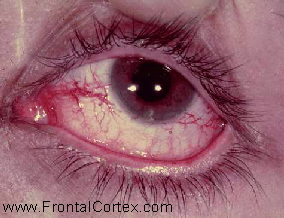Last modified on Saturday, February 17 2007.

Image courtesy of National Eye Institute, National Institutes of Health
A 9 year-old male presents with a history of dysarthric speech, choreoathetosis, ataxia of the limbs, and grimacing, which have been slowly progressing since early childhood.
On exam, you notice the eye findings shown in the image above.
This child is at increased risk for all of the following complications, EXCEPT:
This patient's history and eye findings are diagnostic for ataxia-telangiectasia. This is associated with an increased risk of T-cell lymphoma (
This patient's history and eye findings are diagnostic for ataxia-telangiectasia. Cerebellar degeneration is a frequent finding in ataxia-telangiectasia. (
This patient's history and eye findings are diagnostic for ataxia-telangiectasia. This is associated with an increased risk of B-cell lymphoma (
This patient's history and eye findings are diagnostic for ataxia-telangiectasia. This is associated with immunodeficiency. (
This patient's history and eye findings are diagnostic for ataxia-telangiectasia. Increased incidence of pheochromocytoma is not associated with ataxia-telangiectasia. (
| 1. Santos, C.C., Miller, V.S., and Roach, E.S. (2004). Neurocutaneous syndromes. In Bradley, W.G., Daroff, R.B., Fenichel, G.M., and Jankovic, J. (Eds.). Neurology in Clinical Practice, 4th Edition. Butterworth Heinemann, Philadelphia. Pp. 1867-1900. | |
| 2. NINDS Ataxia Telangiectasia Information Page, NINDS. http://www.ninds.nih.gov/disorders/a_t/a-t.htm | |
| 3. Victor, M., and Ropper, A.H. (2001). Adams and Victor's Principles of Neurology, 7th Edition. McGraw-Hill, New York. Pp. 1011-1012. | |
























